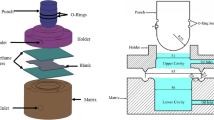Abstract
Leaded Free Machining Steel (FMS) specimens were tested in tension at quasi-static and high strain rates in both the longitudinal and transverse directions with respect to the axis of the bar material. For the quasi-static tests, a high degree of anisotropy of fracture behaviour was observed for both plain (unnotched) and notched specimens. However the difference in fracture strains for longitudinal and transverse directions was significantly reduced for the high stress triaxiality conditions produced by the sharper notches. Plain specimens tested at dynamic strain rates (103 s−1) failed at somewhat higher strains than those tested quasi-statically. For the notched specimens tested dynamically, there was a transition to a brittle mode of failure and there was no statistically significant anisotropy in the very low strains to failure recorded. These experimental results were linked to numerical predictions of the local stress, strain and strain rate conditions in the specimens carried out using a modified Armstrong–Zerilli constitutive model for the FMS. Changes in the percentage area and aspect ratio of the lead inclusions which act as sites for void growth under ductile failure conditions were measured for both longitudinal and transverse directions of loading. It was found that the apparent area of inclusions increases with degree of deformation due to void growth but that the aspect ratio decreases due to the inclusions/voids becoming more spherical. This effect was greater for loading in the transverse direction indicating that voids grow more readily from inclusions when the latter are aligned perpendicular to the direction of loading.
Similar content being viewed by others
References
Andrews, T.D. (2004). Private communication.
Barton, D.C. (2002). Numerical modelling of the dynamic fracture process in ductile metals, Pro. DYMAT Con. on Behaviour of Materials at High Strain Rates.Seville, pp. 1–12.
D.C. Barton (2004) ArticleTitleDetermination of the high strain rate fracture properties of ductile materials using a combined experimental/numerical approach International Journal of Impact Engineering 30 1147–1159 Occurrence Handle10.1016/j.ijimpeng.2004.01.006
A. Butler P. Church B. Goldthorpe (1994) ArticleTitleA wide ranging constitutive model for bcc steels Jnl De Physique IV C8 471–476
Cameron, E.C. (2003). Deformation and fracture characteristics of ductile metals. MPhil thesis, University of Leeds, UK.
E.C. Cameron D.C. Barton T.D. Andrews P.D. Church (2000) ArticleTitleAn experimental and numerical study of the ductile fracture process for rolled homogeneous armour alloy steel Journal De Physique IV 10 209–214
W.M. Garrison N.R. Moody (1987) ArticleTitleDuctile fracture Journal of Physics & Chemistry of Solids 48 IssueID11 1035–01074
J.W. Hancock A.C. Mackenzie (1976) ArticleTitleThe mechanics of ductile fracture in high strength steel subjected to multi-axial stress state Journal of Mechanics and Solids 24 147–169 Occurrence Handle10.1016/0022-5096(76)90024-7
A.C. Mackenzie J.W. Hancock J.K. Brown (1977) ArticleTitleThe influence of state of stress on the ductile failure initiation in high strength steel Engineering Fracture Mechanics 9 167 Occurrence Handle10.1016/0013-7944(77)90062-5 Occurrence Handle1:CAS:528:DyaE2sXkt1Krs7o%3D
F.A. McClintock (1968) ArticleTitleA criterion for the ductile fracture by the growth of holes Journal of Applied Mechanics 35 363–371
A.A. Mir D.C. Barton T.D. Andrews P.D. Church (2003) ArticleTitleAnisotropic ductile failure in titanium alloy at quasi-static and high strain rates Journal De Physique IV 110 571–576 Occurrence Handle1:CAS:528:DC%2BD3sXosFamsrs%3D
Nahme, H. and Worswick, M.J. (1994). Dynamic properties and spall plane formation of brass. Journal De Physique IV 4, Coll. C8.
J.R. Rice D.M. Tracey (1969) ArticleTitleThe ductile enlargement of voids in triaxial stress fields Journal of Mechanics and Physics of Solids 17 201–217 Occurrence Handle10.1016/0022-5096(69)90033-7
Author information
Authors and Affiliations
Corresponding author
Rights and permissions
About this article
Cite this article
Mir, A.A., Barton, D.C., Andrews, T.D. et al. Anisotropic ductile failure in free machining steel at quasi-static and high strain rates. Int J Fract 133, 289–302 (2005). https://doi.org/10.1007/s10704-005-4943-2
Received:
Accepted:
Issue Date:
DOI: https://doi.org/10.1007/s10704-005-4943-2




